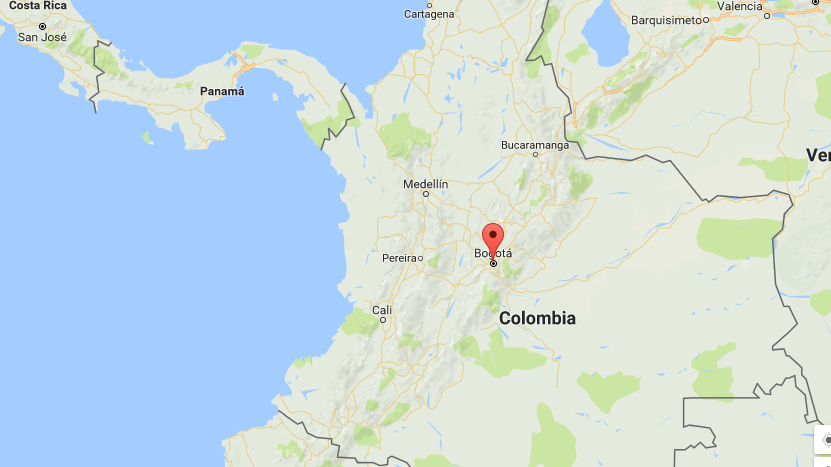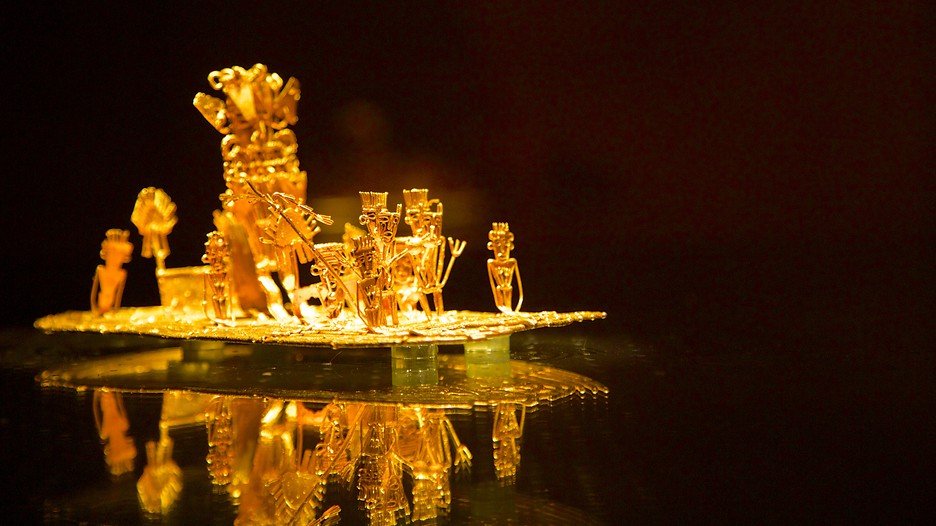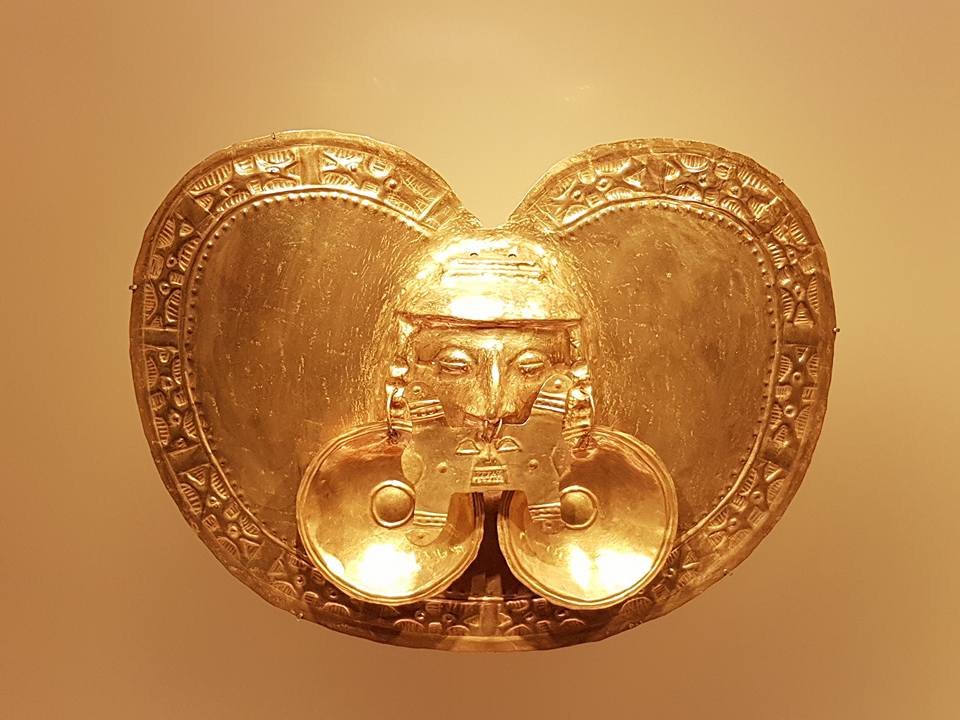Bogotá D.C. (Bogotá Distrito Capital) is the capital of Colombia and the state of Cundinamarca in the center of the country.

It is located right in the middle of the Andes, 2640 meters over the sea level and counts almost 10 million inhabitants. In 2015 it was Nr. 39 of the biggest cities in the world.
Just as most of the American countries, Colombia also was already populated, when the Spanish arrived.
The city used to be the capital of the Muisca civilization and its name was Bacatá.
Just like in Mexico city, the original town was built on top of a big lake and the Spanish conquered it, covered the lake and used the stones of the original town to build their houses and churches. The name almost stayed the same though.
It has a very weird clima!! When I arrived the temperature was 23 degrees. At night it went down to almost 5 degrees and the next day it went up and down between 11 and 19 degrees during the day.
It can be very cold because of the altitude, but it is still necesary to put sun screen on, as it is close to the equator.
The agency The True Colombian is offering a free walking tour through the historic city center every day at 10am and 14:00pm.
They meet at a typical colonial "plaza" and go on from here over 3 hours.
I took the tour and have to say, that it is the best way to get a first impression of the city and the colombian culture.
We got a lot of information and tastes of Colombia ;)
Most of the buildings are built with a colonial architecture - very colorful and charming. Of course you also find a lot of fountains and churches everywhere.
The touristy part of the city is called Candelaría. This is also the area, where most of the hostals are located.
Here you are walking in small streets, passing by a lot of restaurants, cafés, souvenir shops and hotels. The area is very safe and has it´s own flair.
A lot of the walls are painted with graffitis. This is illegal in Colombia, but very important for the inhabitants.
It is their way to express their political beliefs and call attention to subjects, which are avoided by the government and the newspapers.
Therefore most of the graffitis have a deeper meaning, talking about the drug war, corruption or the native american roots of the Colombians.
At our tour we learned a lot about Colombian habits, that I want to share with you.
One of the typical practises is drinking chicha:
Chicha is a really tipical drink in Latin America. It is made out of fermented maiz and therefore contains alcohol.
It was prohibited during centuries until 1991, but is such a big tradition to the native Colombians, that it always could be found.
A true Colombian drinks it every day in the morning. The only other alcoholic drink that colombians consume a lot is beer.
Another important tradition is to chew Coca leafs. Therefore we went to a Coca store and tried some leafs and a Coca Tea, which was surprisingly tasty.
Here Coca leafs are consumed to stimulant or overcome fatigue, hunger and thirst. It is also helpfull against altitude sickness and helps against the pain of headache, rheumatism, wounds and sores.
Back in the days it was often used as painkiller for broken bones, childbirth and operations. Also it helped as a malaria treatment, ulcers and asthma.
Coca leafs and tea are really healthy as it contains nutritional properties such as minerals (calcium, potassium, phosphorus), vitamins (B1, B2, C, and E).
Our guide told us that in most countries coca leafs are forbitten, because they are also used to produce cocaine. More about that and the drug situation in Colombia here:
After trying the Coca leafs we went on to the fruit market. Here we learned something about the colombian food habits.
Of course we also could try a few of the fruits and Doña Gloria made us a fruit drink according to our wishes ;)
Here you can see the menu and the explination of the colombian expressions in the video.
I also ordered some tipical "Asado" (barbecue) with frensh fries. - Delicious.
Of course the town also counts with some historic places. Our next stop was Plaza Simón Bolívar. - The main place of the city!
Here you find the Palace of Justice on the northern edge and the National Capitol in the south. The Primary Cathedral of Bogotá and the Liévano Palace, seat of the mayor of Bogotá, are situated on the eastern and western side respectively.
The cathedral had already been prepared to receive the pope, which would come 2 days after our departure ;)
On the outside people where selling religious stuff, t-shirts, caps, etc.
Maybe you recognize the Palace of Justice from the TV Show "Narcos" because one of the key moments of the war against Pablo Escobar took place right here.
If you go on at the septima (7th street), you will find a lot of people doing entertainment or shows. This area is very alive ;)
Of course the city offers also a lot of museums to visit. It counts more than 58 and also 62 galleries to be precicely.
The most important ones are the national museum, the colonial art museum and the gold museum.
With more than 38. 000 pieces it is the most important collection of pre colombian gold art of the world. Most of the pieces are suns, plants or animal figures, which glow at night.
They where found in the famous El dorado-Lagune on Guatavita. (More about that sight soon!!)


Another important sight in Bogotá is the Monserrate hill. It is a little mountain with a church on top. You can see it from almost everywhere in the city and it helps you for your orientation :D
A cable car takes up to 40 passengers to the top (3152 metros) for just 20 000 COP.
For the Muisca civilization the two mountains where sacret, because the sun rises just in the middle.
That is why the Spanish put the Monserrate Church on the left and a statue of the Virgen of Guadalupe on the right.

The church was built in the 17th century and is very popular for pilgrims. It is quite simple though.
Behind the Church you find cafés, restaurants and a big handcraft market to buy souvenirs.
I must say, that for me it is not a very special place to be, but the view of the city is outstanding. Seeing the city from out here makes you realize, how big it is!!
I hope you liked the post and I am always grateful for your Upvote, Resteem & Follow as you are supporting my world trip with it!
Cheers, Liz








